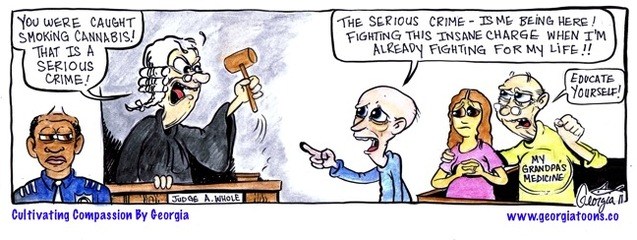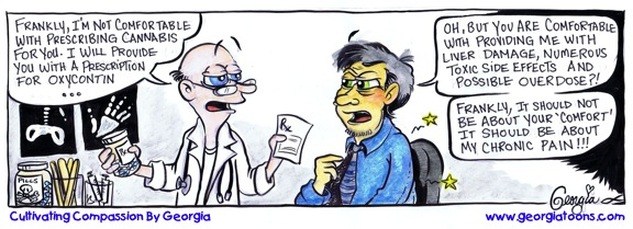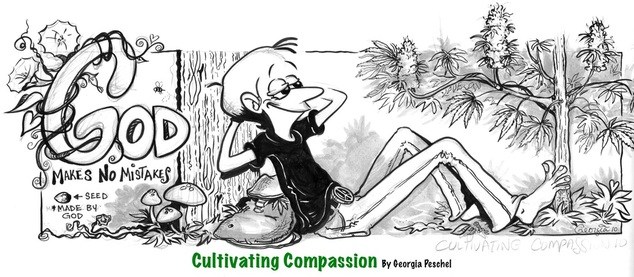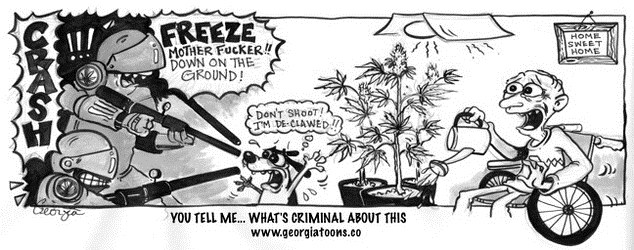
Minor, or major,…ALL Phytocannabinoids are great.~Truth
Lets hear it for phytocannabinoids!!!
Phytocannabinoids…Cannabis has a long history of medicinal use, with evidence dating back to 2,000 B.C.E
An Irish physician, William Brooke O’Shaughnessy, is credited with introducing the therapeutic use of cannabis to Western medicine. He was Assistant-Surgeon and Professor of Chemistry at the Medical College of Calcutta, and conducted a cannabis experiment in the 1830s, first testing his preparations on animals, then administering them to patients in order to help treat muscle spasms, stomach cramps or general pain. Cannabis as a medicine became common throughout much of the Western world by the 19th century. It was used as the primary pain reliever until the invention of aspirin.[1] Modern medical and scientific inquiry began with doctors like O’Shaughnessy and Moreau de Tours, who used it to treat melancholia and migraines, and as a sleeping aid, analgesic and anticonvulsant.
Things “dried up” so to speak, and were brought to an end for Indian Hemp/Cannabis,..well above ground anyways. The new underground cannabis biz would begin to flourish not much longer after the United States banned cannabis in a federal law, in the 1937 Marijuana Tax Act,..another big greedy decision made by “the powers that be”… then came the slanderous, defaming stereotypes promoted by the media, that the drug was used primarily by Mexican and African immigrants.etc.etc.
Ever been through something similar to this? ^^^…well,..speak up… education is thee key!!
 ~ Truth!
~ Truth!
Phytocannabinoids are a natural group of bustling compounds found in Indian Hemp/Cannabis Sativa L. The wider definition of cannabinoids refer to a group of substances that are typically, structurally related to tetrahydrocannabinol, While cannabinoids that occur uniquely in the cannabis plant are called phytocannabinoids, another natural form of cannabinoids are thee endogenous cannabinoids, produced in the bodies of humans and ALL mammals. At least 85 phytocannabinoids have been isolated from the cannabis plant, and the most often noted are: THC (Δ9-tetrahydrocannabinol), CBD (cannabidiol) and CBN (cannabinol). Phytocannabinoids bind to to cannabinoid receptors.
~Note: not all phytocannabinoids have psychoactive properties(think about that).
Humans who are awake, now know that synthetic cannabinoids are poisonous, adulterated cannabinoids.
Every living creature should also stay away from patented & marketed forms of Big Pharma’s FDA approved cannabis derivatives,.. example: Sativex(~btw,…SATIVEX,..YOU’RE DOING IT WRONG!). Now, just look at how this overpriced “invention” Sativex,..which is MAINLY ONLY TWO cannabinoids…{and I believe Humans require ALL of the pure,natural full spectrum of all cannabinoids for the best healthcare,..shame on them} is reported to help with sayyyy M.S(…well yeah it will!!!, but only partly… because of the framework benefits of cannabinoids. BUT adding.04g alcohol gives Humans Mouth problems, including burning, pain or mouth ulcers…among several other un-natural side effects caused by this so called “invention”. ~truth
,..and who really needs that peppermint oil flavouring in it too. I’d prefer to get that naturally from my peppermint herb/plant(while it’s still legal to grow).
 ~Truth(Thank You Georgia!!) georgiatoons Comic Strip Cartoonist ^^^
~Truth(Thank You Georgia!!) georgiatoons Comic Strip Cartoonist ^^^
Common Cannabinoid Types…
Tetrahydrocannabinol (THC), cannabidiol (CBD), cannabinol (CBN), and dodeca-2E,4E,8Z,10E/Z-tetraenoic-acid-isobutylamides (from Echinacea species) are the most prevalent natural cannabinoids and have received the most study. Other common cannabinoids are listed below:
- CBG (Cannabigerol)
- CBC (Cannabichromene)
- CBL (Cannabicyclol)
- CBV (Cannabivarin)
- THCV (Tetrahydrocannabivarin)
- CBDV (Cannabidivarin)
- CBCV (Cannabichromevarin)
- CBGV (Cannabigerovarin)
- CBGM (Cannabigerol Monomethyl Ethers)
Separation
Cannabinoids can be separated from the plant by extraction with organic solvents. Hydrocarbons andalcohols are often used as solvents. However, these solvents are flammable and many are toxic. Butane may be used, which evaporates extremely quickly. Supercritical solvent extraction with carbon dioxide is an alternative technique. Although this process requires high pressures (73 atmospheres or more), there is minimal risk of fire or toxicity, solvent removal is simple and efficient, and extract quality can be well controlled. Once extracted, cannabinoid blends can be separated into individual components using wiped film vacuum distillation or other distillation techniques. However, to produce high-purity cannabinoids,chemical synthesis or semisynthesis is generally required.
Plant synthesis
Cannabinoid production starts when an enzyme causes geranyl pyrophosphate and olivetolic acid to combine and form CBG. Next, CBG is independently converted to either CBD or CBC by two separate synthase enzymes. CBD is then enzymatically cyclized to THC. For the propyl homologues (THCV, CBDV and CBNV), there is a similar pathway that is based on CBGV. Recent studies[which?] show that THC is not cyclized from CBD but rather directly from CBG. No experiment thus far has turned up an enzyme that converts CBD into THC, although it is still hypothesized[by whom?].
How well do you know your medicine?
CBG is a “precursor” to THC & CBD(also please refer to “Plant Synthesis” above ^^^.
^^^ Take a look at what medical benefits CBG has and how it is synthesized in the cannabis plant^^^
CBG inhibits Gaba uptake, Gaba is a neurotransmitter in your brain, when Gaba is inhibited you will have muscle relaxation , and anti-anxiety effects(similar to CBD), also has anti depressant properties, and even some anti-fungal properties too.
Cannabigerol (CBG) is non-psychotomimetic but still affects the overall effects of Cannabis. It acts as an α2-adrenergic receptor agonist, 5-HT1A receptor antagonist, and CB1 receptor antagonist.[27] It also binds to the CB2 receptor.
THCA-Tetrahydrocannabinolic acid (THCA, 2-COOH-THC). is a biosynthetic precursor of tetrahydrocannabinol (THC), the active component of Cannabis.
THCA is found in variable quantities in fresh, undried cannabis, but is progressively decarboxylated to THC with drying, and especially under intense heating such as when cannabis is smoked. While THCA does not have psychoactive effects in its own right, it has the ability to modulate the Immune System as well as also provides anti-inflammatory and neuroprotective effects. Despite the ready decarboxylation by drying or heating ex vivo, conversion of THCA to THC in vivo appears to be very limited, giving it only very slight efficacy as a prodrug for THC.[8] Consequently it is believed to be important in less-psychoactive preparations of cannabis used for medical use, such as cannabis tea.[9.
Tetrahydrocannabinol, a.k.a delta-9-tetrahydrocannabinol (Δ9-THC).
Get an intensive crash course on the benefits of THC as well as how it is synthesized in the cannabis plant, and tested for using standardized methods by SC Labs.
**You CANNOT overdose on THC,..so,.. please understand Cannabis/Cannabinoids are NOT “drugs” at all,..Big Pharma sells those types of “drugs”,..THOSE can/will KILL you,..if you disagree,.you need wake up, to re-program yourself, ..you were taught wrong!!.,..tis’ a God given, naturally healthy and beneficial plant for ALL mammals.
THC is a neuroprotectant.
Anju Preet Ph.D, and Harvard researchers re-discovered THC inhibits tumours(..lung, AND a specific type of brain cancer—2007).THC is helpful for PTSD,.. and Tourette’s syndrome. THC has medicinal anti-inflammatory effects,..actually THC has been found to be 20 times stronger than Aspirin, and twice as strong as the well known “drug” Hydrocortisone(… D. Kosersky conducted these anti-inflammatory studies). THC has been found to be a strong anti-oxidant. THC stimulates appetite works well preventing or arresting vomiting(has antiemetic properties)…one more reason it helps Humans who go through with the side effects of poisonous chemotherapy….which by the way,..
…”Chemotherapy is leftover from World War 1&2 based on Mustard Gas. MG is forbidden as a war chemical at Geneva Convention. That’s what they put directly into the bloodstream of people and hoping when after everything dies. That the patient still stays alive only the good cells renew and the Cancers cells will not! Oncologists are all murderers because nobody can be cured of by any Oncology treatment POISON, CUT, SLAUGHTERED and RADIATED to death” – Dr. Leonard Coldwell
Delta-9-tetrahydrocannabinol (Δ9-THC, THC) and delta-8-tetrahydrocannabinol (Δ8-THC), mimic the action of anandamide, a neurotransmitter produced naturally in the body. These two THC’s produce the effects associated with cannabis by binding to the CB1 cannabinoid receptors in the brain.
…look at the little-known cannabinoid known as THCV and how it benefits patients, as well as its synthesis in the cannabis plant! ^^^
Tetrahydrocannabivarin (THCV, THV) is a homologue of tetrahydrocannabinol (THC) having a propyl (3-carbon) side chain. This terpeno-phenolic compound is found naturally in Cannabis, sometimes in significant amounts. Plants with elevated levels of propyl cannabinoids (including THCV) have been found in populations of Cannabis sativa L. ssp. indica (= Cannabis indica Lam.) from China, India, Nepal, Thailand,Afghanistan, and Pakistan, as well as southern and western Africa. THCV levels up to 53.7% of total cannabinoids have been reported.
THCV has been shown to be a CB1 receptor antagonist, i.e. it blocks the effects of THC.
In using THCV in lab-studies they found(when it blocks) it can cause weight loss and decreased body fat, and increased energy expenditure in mice. THCV(in the lab) has also been found to have anti-convulsant properties too.
Tetrahydrocannabivarin (THCV) is prevalent in certain central Asian and southern African strains of Cannabis.[28][29] It is an antagonist of THC at CB1 receptors and attenuates the psychoactive effects of THC.
…medical benefits CBDA has and how it is synthesized in the cannabis plant! ^^^
CBDA(Cannabidiolic acid) is a precursor to CBD(Cannabidiol). It has anti-proliferative(prevents cells,..especially cancer cells from proliferating), and CBDA has some anti-inflammatory properties too.
...look at the benefits of Cannabidiol (CBD) and how it is synthesized in the cannabis plant. ^^^
CBD- Cannabidiol (CBD) is a cannabinoid found in cannabis. It is a major constituent of the plant, representing up to 40% in its extracts.[2]. Cannabidiol (CBD) is not particularly psychoactive in and of itself, and was thought not to affect the psychoactivity of THC.
It has displayed sedative effects in animal tests.[3] Some research, however, indicates that CBD can increase alertness.[4] It may decrease the rate of THC clearance from the body. Medically, it has been shown to relieve convulsion,..and has been shown in studies to help the body NOT make the chemical that causes inflammation. CBD also helps anxiety, and nausea, as well as inhibit cancer cell growth. Recent studies have shown cannabidiol to be as effective as a typical antipsychotics in treating schizophrenia.]Studies have also shown that it may relieve symptoms of dystonia.
In November 2007, it was reported that CBD reduces growth of aggressive human breast cancer cells in vitro and reduces their invasiveness.[9] It’s also shown that Cannabidiol reduces anxiety in social anxiety disorder.
Cannabidiol has little affinity for CB1 and CB2 receptors but acts as an indirect antagonist of cannabinoid agonists. Recently it was found to be an antagonist at the putative new cannabinoid receptor, GPR55, a GPCR expressed in the caudate nucleus and putamen. Cannabidiol has also been shown to act as a 5-HT1A receptor agonist,[19] an action that is involved in its antidepressant, anxiolytic, and neuroprotective effects. CBD has a greater affinity for the CB2 receptor than for the CB1 receptor.
CBC-Cannabichromene (abbreviated as CBC,..the third cannabinoid that is synthesized from CBG), is a cannabinoid found in the cannabis plant. It bears structural similarity to the other natural cannabinoids, including tetrahydrocannabinol, tetrahydrocannabivarin, cannabidiol, and cannabinol, among others. Evidence has suggested that it plays a role in the anti-inflammatory, anti-fungal and anti-viral effects of cannabis, and may contribute to the overall analgesic effects of medical cannabis.
Cannabichromene (CBC) is non-psychoactive and does not affect the psychoactivity of THC . Tetrahydrocannabivarin (THCV) is prevalent in certain central Asian and southern African strains of Cannabis.[28][29] It is an antagonist of THC at CB1 receptors and attenuates the psychoactive effects of THC
CBN(Cannabinol)–Not to be confused with Cannabidiol, a cannabinoid that is less psychoactive and which is sometimes erroneously called/pronounced ‘Cannabinol’.
Cannabinol (CBN) is a psychoactive substance cannabinoid found in Cannabis sativa and Cannabis indica/afghanica.[1] It is also a metabolite of tetrahydrocannabinol (THC).[2] CBN acts as a weak agonist of the CB1 and CB2 receptors, with lower affinity in comparison to THC.
CBN is another cannabinoid,..however it is not naturally synthesized from the cannabis plant, it appears to be found from the breakdown of THC,.. therefore CBN is considered a breakdown product or metabolite of THC. CBN can be found in any, and ALL cannabis(CBN content increases as THC degrades in storage, and with exposure to light and air. It is only mildly psychoactive), CBN can make you sleepy, it has sedative properties, and works well as an anti-convulsant too. CBN even has anti-bacterial and anti-inflammation properties too. CBN is also being looked at for treatments in bone disorders such as Osteoporosis. It’s affinity to the CB2 receptor is higher than for the CB1 receptor.
~~~
Terpene interplay~In this episode of Know Your Medicine, join Dr. Bonni Goldstein as she sits down with three other experienced cannabis experts, and discusses with them how terpenes chemically interact with the rest of the cannabinoids to produce certain effects.
Terpenes are the molecules for door that are found in the essential oils of plants.
Some terpenes are said to modulate the physiological and psychoactive effects of cannabis.
…all these people hollering about CBD right now have it wrong,..THCV is the one everybody wants to chase right now… –Steve Tuck
“…terpenes act synergistically with cannabinoids” “…I myself(for me) agree. Go for the highest THC, and THCV(tis’ a beautiful thing) for some of the most serious diseases & disorders etc”.~Freedom
;-)’
Take a closer look at the dangerous practice of using plant growth regulators in cannabis growing.
Most plant growth regulators have been banned in the U.S for food crops(…for several years now,..like 80s)….problem is trash like this has found it’s way into the “growing industry” of medicinal cannabis.
Beware of growth inhibitors such as for example: Top Load, Phosfoload, Bushmaster, Gravity, and Flower Dragon.
….just a wee message/warning for some growers.
Stay away from these types of poisons too. ~Truth
~~~
Yes,.. there is a better way,.. and it involves a robust ECS.
..btw,..check out big~man playing that BIG~bottomed, 3 stringed bass~~~Dig~it! PpP(<—— to da’ left).
…don’t give up on Truth folks,…cause Truth hasn’t given up on us.
~~Peace~~
~OneLove~
P.S… GYO !!!
;-)’


Thank You Georgia!!) georgiatoons Comic Strip Cartoonist
http://en.wikipedia.org/wiki/Cannabinoid
http://www.cbg-meb.nl/NR/rdonlyres/214BF38E-9F37-4C9B-AC0B-CFCB5EB3F421/0/SativexMHRAEPAR.pdf



